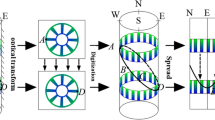Abstract
Rock mass classification has been playing an important role in the analyses of civil engineering in recent years. The quality evaluation of slope rock mass becomes essential for slope stability assessment. Neither continuous expression and comparable function are rarely taken into consideration in rock mass classification, nor is the shortage in the previous quality evaluation of slop rock mass. Through constructing the benchmark intervals of evaluation indicators; mathematical models between quantized value and relative quantized value which is a new proposed parameter; and linear weighted function, the interval continuous mathematical models (ICMM) for quality evaluation of slope rock mass are presented. The application result shows that ICMM is effective for improving the comparability of rock mass quality of slopes by unifying evaluation indicators. On the other hand, the ICMM realizes the continuous expression of rock mass quality of slopes by removing the step-like features caused by the pre-set rating criteria of each evaluation indicator and rock mass quality classification, guiding the follow-up construction and protection of slopes, and ensuring the balance between economy and safety. Therefore, the ICMM is more scientific and reasonable than extant classification systems for evaluating rock mass quality of slopes.






Similar content being viewed by others
References
Aydan Ö, Ulusay R, Tokashiki N (2014) A new rock mass quality rating system: rock mass quality rating (RMQR) and its application to the estimation of geomechanical characteristics of rock masses. Rock Mech Rock Eng 47:1255–1276
Azarafza M, Akgun H, Kaljahi EA (2017) Assessment of rock slope stability by slope mass rating (SMR): a case study for the gas flare site in Assalouyeh, south of Iran. Geomech Eng 13:571–584
Barton N, Lien R, Lunde J (1974) Engineering classification of rock masses for the design of tunnel support. Rock Mech 6:189–236
Bieniawski ZT (1973) Engineering classification of jointed rock masses. Trans S Afr Inst Civil Eng 15:335–343
Bieniawski ZT (1979) The geomechanics classification in rock engineering applications. Proceeding of the 4th International Congress on Rock Mechanics, Montreux
Bieniawski ZT (1989) Engineering rock mass classification. Wiley, New York
Chen ZY (1995) Recent developments in slope stability analysis. Proceedings of the 8th International Congress on Rock Mechanics, Tokyo
Daftaribesheli A, Ataei M, Sereshki F (2011) Assessment of rock slope stability using the fuzzy slope mass rating (FSMR) system. Appl Soft Comput 11:4465–4473
Deere DU (1964) Technical description of rock cores for engineering purpose. Rock Mech Eng Geol 1:17–22
Fereidooni D, Khanlari GR, Heidari M (2015) Assessment of a modified rock mass classification system for rock slope stability analysis in the Q-system. Earth Sci Res J 19:147–152
Hamidi JK, Shahriar K, Rezai B, Rostami J (2010) Performance prediction of hard rock TBM using rock mass rating (RMR) system. Tunn Undergr Sp Tech 25:333–345
Ji F, Shi YC, Li RJ, Zhou CH, Zhang N, Gao JS (2019) Modified Q-index for prediction of rock mass quality around a tunnel excavated with a tunnel boring machine (TBM). B Eng Geol Environ 78:3755–3766
Jordá-Bordehore L (2017) Application of Q (slope) to assess the stability of rock slopes in Madrid province, Spain. Rock Mech Rock Eng 50:1947–1957
Laubscher DH (1990) A geomechanics classification system for the rating of rock mass in mine design. J S Afr Inst Min Metall 90:257–273
Liu DX, Cao P (2015) Preliminary study of improved SMR method based on gray system theory. Rock Soil Mech 36:408–412 (in Chinese)
Liu KY, Liu BG, Fang Y (2019) An intelligent model based on statistical learning theory for engineering rock mass classification. B Eng Geol Environ 78:4533–4548
Morales M, Panthi KK, Botsialas K (2019) Slope stability assessment of an open pit mine using three-dimensional rock mass modeling. B Eng Geol Environ 78:1249–1264
Pantelidis L (2010) An alternative rock mass classification system for rock slopes. B Eng Geol Environ 69:29–39
Pells PJ, Bieniawski ZT, Hencher SR, Pells SE (2017) Rock quality designation (RQD): time to rest in peace. Can Geotech J 54:825–834
Rad HN, Jalali Z (2019) Modification of rock mass rating system using soft computing techniques. Eng Comput-Germany 35:1333–1357
Riquelme AJ, Tomas R, Abellan A (2016) Characterization of rock slopes through slope mass rating using 3D point clouds. Int J Rock Mech Min Sci 84:165–176
Romana MR (1985) New adjustment ratings for application of Bieniawski classification to slopes. Proceeding of the International Symposium on Role of Rock Mechanics. Zacatecas, Mexico
Saroglou C, Qi SW, Guo SF, Wu FQ (2019) ARMR, a new classification system for the rating of anisotropic rock masses. B Eng Geol Environ 78:3611–3626
Singh RP, Dubey CS, Singh SK, Shukla DP, Mishra BK, Tajbakhsh M, Ningthoujam PS, Sharma M, Singh N (2013) A new slope mass rating in mountainous terrain, Jammu and Kashmir Himalayas: application of geophysical technique in slope stability studies. Landslides 10:255–265
Warren SN, Kallu RR, Barnard CK (2016) Correlation of the Rock Mass Rating (RMR) System with the Unified Soil Classification System (USCS): Introduction of the Weak Rock Mass Rating System (W-RMR). Rock Mech Rock Eng 49:4507–4518
Yardimci AG, Karpuz C (2018) Fuzzy approach for preliminary design of weak rock slopes in lignite mines. B Eng Geol Environ 77:253–264
Acknowledgments
Financial support for this work, provided by the Central South University Innovation Leadership Talents Project (506030101) and the Huxiang High-level Talents Aggregation Project Innovation Talents Project (2018RS3013), is gratefully acknowledged.
Author information
Authors and Affiliations
Corresponding author
Rights and permissions
About this article
Cite this article
Wu, L., Liu, D. & Cao, P. A new method for evaluating rock mass quality of slopes based on interval continuous mathematical models. Bull Eng Geol Environ 79, 1357–1364 (2020). https://doi.org/10.1007/s10064-019-01661-5
Received:
Accepted:
Published:
Issue Date:
DOI: https://doi.org/10.1007/s10064-019-01661-5




